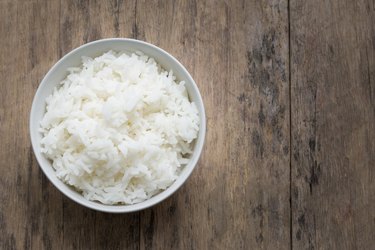
There are numerous varieties of rice; which one you use is an important factor influencing the calories in rice. White rice will have different nutrient profiles and caloric content than other varieties of rice. The calorie count of a bowl of rice depends on the type of rice you are eating.
Calories in White Rice
Video of the Day
According to the United States Department of Agriculture's National Nutrient Database, a single bowl of cooked, long-grain white rice contains about 242 calories. It also contains more than 53 grams of carbohydrates and only a very small portion of dietary fiber. Most of the carbohydrate content, and therefore the calories in rice, is in the form of starch, with a small amount in the form of sugar.
Video of the Day
Rice is considered to be a significant source of starch, and 1 cup of rice's carbs will therefore mostly be starch. If you are trying to restrict your carbohydrate consumption on a low-carb diet, or because you have diabetes, then you should be careful about portion sizes.
White rice has a glycemic index of 73, which means it will significantly increase your blood sugar. Brown rice has a glycemic index of 68.
White rice has almost zero fat content on its own. If you cook white rice without adding any butter or oil, then you will get almost no fat from it at all.
A single bowl of rice contains over 4 grams of protein, which makes it an unexpectedly good source of protein, albeit what you get from 1 cup of rice's protein is still lower than what you would get from protein-rich foods. For the most part, 1 cup of rice is really just 1 cup of rice carbs.
There are also micronutrients that can be found in a bowl of rice. In fact, depending on the specific type of rice you are consuming, you can get a variety of micronutrients in significant amounts, including iron, fiber, and B vitamins like riboflavin, niacin and thiamin.
Enriched rice has had the minerals and vitamins added back after its refinement process. Fortified rice has had other minerals that weren't there originally, before the refinement process, added to the rice after refinement is complete. All fortified rice is enriched rice, but not all enriched rice is fortified rice.
Different Types of Rice
Apart from the traditional brown rice versus white rice distinction, there are other categories into which rice is divided, based on grain size. Rice can be short grain, medium grain, or long grain. Even within these categories, there are different ways in which the rice is processed.
There is converted rice, which has had the surface starch removed through parboiling. This makes it easier to pearl by hand. Converted rice cooks faster than regular processed white rice, and retains more of its nutrients. However, the carbohydrate count of 1 cup of rice remains essentially the same, whether you're dealing with parboiled rice or regular rice.
There is also quick-cooking rice, also known as instant rice, which is fully cooked first, and then flash frozen. Some of the flavor and nutrients will be lost in the process, but it does cook very quickly.
Other varieties of rice include Arborio rice, sticky rice, basmati rice, wild rice, brown rice and wild pecan rice.
Health Benefits of Rice
According to Beyond Celiac, all rice is gluten-free. For this reason, it has recently gained massive popularity among those who want to stay away from wheat products. In fact, by focusing on eating brown rice, which has higher fiber content, according to the USDA National Nutrient Database, you can easily make regular rice-eating part of a healthy diet.
Most of the health benefits of rice, however, come from all the micronutrients it contains. The B vitamin thiamin, for example, is important in the metabolism of carbohydrates. Magnesium is not only important in forming the structure of bones, but also assists in enzyme reactions that synthesize DNA and different proteins. It is also important for muscle contraction, and for nerve conduction.
Manganese is important for protein and carbohydrate metabolism. It is a crucial component of the antioxidant enzymes that assist in these processes.
Additionally, brown rice has more vitamins than regular white rice, and more minerals, such as selenium. Selenium is another important component in antioxidant enzymes and also influences the proper functioning of the thyroid. Brown rice also has at least seven times more dietary fiber than white rice.